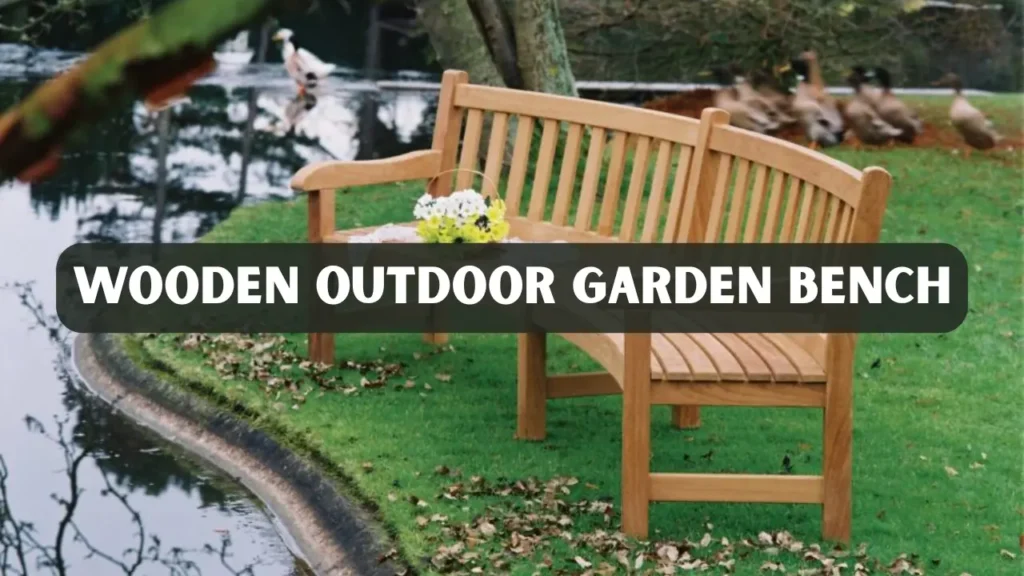A wooden outdoor garden bench is more than just a place to sit. It can become a central feature in your backyard or patio, offering both functionality and aesthetic appeal. A well-placed bench provides a cozy spot for morning coffee, a comfortable place to read, or extra seating for guests during outdoor gatherings. Building your own bench allows you to personalize it according to your available space, preferred wood type, and design style. Unlike pre-made benches, a DIY project gives you the flexibility to create a piece that reflects your personality and complements your garden.
This guide provides a detailed, step-by-step approach to crafting a beautiful, durable, and weather-resistant bench. With careful planning and execution, even beginners can achieve results that are both functional and visually appealing. Following these instructions will ensure that your bench becomes a long-lasting centerpiece for your outdoor space.
Why Choose a Wooden Outdoor Garden Bench
Wood is a classic choice for outdoor furniture because it combines durability, versatility, and natural beauty. Unlike metal or plastic alternatives, wood can be customized easily, offering a warm and inviting look that blends seamlessly into outdoor surroundings. Constructing your own bench allows you to select the exact dimensions, style, and wood type to fit your garden perfectly.
A wooden bench also offers long-term durability when properly maintained. Woods such as teak, cedar, and redwood naturally resist decay and insect damage, making them ideal for outdoor use. Additionally, building your own bench can be more cost-effective than purchasing a high-quality pre-made piece. Beyond the financial benefits, the process of creating a bench provides a sense of accomplishment and enhances your DIY skills. Choosing wood from sustainable sources also ensures that your project is environmentally friendly, aligning functionality with responsible practices.
Selecting the Right Wood
The type of wood you choose is crucial for the longevity and appearance of your outdoor bench. Each wood species offers unique characteristics that affect durability, maintenance, and aesthetics. Teak is one of the best options because it naturally resists moisture, insects, and weather damage. Over time, it develops a silver-gray patina, adding charm and elegance to any garden.
Cedar and redwood are also excellent choices for outdoor benches. Cedar is lightweight, easy to work with, and naturally resistant to decay and insects, while its warm color and pleasant aroma enhance the garden experience. Redwood offers a rich reddish hue and smooth texture, making it ideal for benches with decorative designs. Both provide durability and aesthetic appeal, though cedar may require occasional sealing.
Acacia and ipe are strong alternatives for long-lasting performance. Acacia is dense and durable, and with a protective finish, it withstands outdoor conditions effectively. Ipe is extremely hard and resists rot, insects, and moisture, making it ideal for heavy-use benches. Applying a weatherproof stain or sealant further protects any wood, preventing cracking, water absorption, and discoloration.
Tools and Materials Needed
Before starting your project, it is important to gather all the necessary tools and materials. Proper preparation helps prevent interruptions and ensures a smooth workflow. A circular saw or hand saw allows for precise cutting of wood planks, while a drill with screwdriver bits is essential for securely assembling the bench. Measuring tape and a pencil are needed for accurate markings, and clamps keep pieces in place during construction.
Sandpaper in medium and fine grits is necessary to achieve a smooth finish on all surfaces. Safety equipment such as gloves, goggles, and ear protection should always be worn to protect yourself while working. Taking the time to prepare these tools ensures both safety and efficiency throughout the project. A well-prepared workspace allows you to focus on building without unnecessary delays.
When it comes to materials, choose wood planks suitable for outdoor use and gather weather-resistant screws and bolts for assembly. Outdoor-grade wood glue adds extra stability, and weatherproof stain or sealant protects the bench from moisture and UV damage. Optional decorative elements like cushions, painted designs, or carved patterns can enhance both the appearance and comfort of your bench. Being fully prepared with materials ensures a more enjoyable and successful DIY experience.
Step by Step Construction Guide
Creating a wooden outdoor garden bench requires careful attention to detail at each stage of the construction process.
Step 1: Planning and Measuring
Begin by measuring your available space and deciding on the bench dimensions. A standard bench length ranges from 48 to 60 inches, with a depth of 16 to 18 inches and a height of 17 to 18 inches. Sketch your design on paper and mark measurements directly on the wood. Accurate planning ensures that your bench fits comfortably in your chosen location and meets your functional needs.
Step 2: Cutting the Wood
Once measurements are marked, cut the wood according to your design. Using clamps and a straight edge guide helps maintain clean, straight cuts. After cutting, sand the edges to remove splinters and rough spots, ensuring a smooth and safe finish. Precision during this stage is crucial, as it affects the assembly and overall appearance of the bench.
Step 3: Assembling the Frame
Begin assembling the bench by constructing the base and carefully attaching the legs. Use screws together with wood glue to create a strong and durable frame. Check frequently to make sure the structure remains level and square. If necessary, add extra support braces to reinforce the frame. These steps help prevent wobbling and ensure the bench stays stable over time.
Step 4: Building the Seat and Backrest
Attach the seat planks evenly across the frame, making sure each plank is aligned properly. When installing the backrest, position it at a slight angle to provide comfortable ergonomic support. Double-check that all screws and joints are tightly secured for stability. Add reinforcements along both the back and seat to help distribute weight evenly. These steps ensure the bench is strong, durable, and safe for regular use.
Step 5: Sanding and Smoothing
After assembling the bench, begin sanding the entire surface with medium-grit sandpaper. Follow up with fine-grit sandpaper to achieve a smooth finish. Pay close attention to corners and edges to remove any sharp spots. A well-sanded surface ensures both comfort and a professional appearance. Proper sanding also helps the wood absorb stain or sealant evenly for long-lasting protection.
Step 6: Finishing and Sealing
Apply a weatherproof stain or sealant in thin, even coats, allowing each layer to dry completely before adding the next. Staining not only enhances the appearance of the wood but also protects it from moisture, sun damage, and insects. Optional decorative touches, such as carved patterns or painted designs, can personalize your bench and create a unique focal point in your garden.
Step 7: Placing Your Bench
Finally, position the bench in your garden, patio, or backyard. Choose a level area that balances sunlight and shade, and consider nearby plants or garden features. Adding cushions or outdoor fabrics increases comfort and can further enhance the visual appeal. Proper placement ensures your bench is functional, accessible, and inviting for daily use.
Design Ideas and Customization
A wooden outdoor garden bench can be customized in various ways to suit your personal style and garden layout. Incorporating armrests adds comfort and a touch of elegance. Curved backrests improve ergonomics while creating a more visually appealing silhouette. For a creative twist, consider integrating small planters on the sides of the bench, which allows you to add greenery directly into the design.
Decorative carvings or painted patterns enhance the visual interest and make the bench unique. Selecting a stain or paint that matches your garden’s color palette helps tie the bench seamlessly into its surroundings. By considering these customization options, you can transform a functional piece of furniture into a striking centerpiece for your outdoor space.
Maintenance Tips
Proper maintenance is essential to extend the life of your wooden outdoor garden bench. Regular cleaning with mild soap and water prevents dirt buildup and reduces the risk of mold and mildew. Reapplying a protective stain or sealant every one to two years helps preserve the wood’s appearance while enhancing its resistance to the elements. During extreme weather, covering the bench or moving it to a sheltered area protects it from sun, rain, and snow.
In addition to cleaning and protection, it is important to inspect screws, bolts, and joints annually. Ensuring that all fasteners are tight and secure keeps the bench stable and safe for use. By following these maintenance practices, you can enjoy your bench for many years without compromising its beauty, durability, or functionality.
Real-World Example
Anna, an avid DIY enthusiast, built a cedar bench measuring 54 inches long and 18 inches high. She finished it with a high-quality weatherproof stain and placed it in a quiet corner of her garden surrounded by flowering plants. The project took her two weekends, and even after three years, the bench remains in excellent condition despite exposure to rain and sun. Her experience shows that careful planning, quality materials, and regular maintenance create a durable and attractive bench. Sharing real-world examples like this provides practical insights for anyone planning their own DIY outdoor bench project.
Conclusion
Building a wooden outdoor garden bench is a rewarding DIY project that combines creativity, skill, and practicality. Selecting the right wood, following detailed construction steps, and applying proper finishing and maintenance techniques ensures a durable, comfortable, and visually appealing bench. This project not only enhances your outdoor space but also provides a sense of accomplishment and personal satisfaction. By taking the time to plan, construct, and care for your bench, you create a piece of furniture that will be enjoyed by family and guests for years to come.
FAQs
What is the best wood for a garden bench?
Teak and cedar are excellent choices due to their resistance to decay, insects, and weathering. Redwood and acacia can also be used effectively with proper maintenance and protective finishes.
How long does it take to build a wooden bench?
The construction of a simple bench typically takes one to two weekends, depending on your experience, tools, and the complexity of your design.
Do I need professional tools for this project?
Basic hand and power tools are sufficient for most DIY benches. A circular saw and drill will help with precision and efficiency, but you do not need specialized professional equipment.
How do I weatherproof my bench?
Weatherproofing involves applying outdoor-grade sealants or stains, ensuring proper drying between coats, and protecting the bench during extreme weather conditions.
Can I customize the bench size and design?
Yes, DIY construction allows you to adjust dimensions, add armrests, create curved backrests, or integrate planters. Decorative carvings or painted designs can further personalize the bench.




